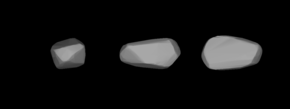 A three-dimensional model of 157 Dejanira based on its light curve. | |
| Discovery[1] | |
|---|---|
| Discovered by | A. Borrelly |
| Discovery date | 1 December 1875 |
| Designations | |
| (157) Dejanira | |
| Pronunciation | /dɛdʒəˈnaɪərə/[2] |
| A875 XA; 1904 VB; 1978 TS1 | |
| Main belt | |
| Orbital characteristics[3][4] | |
| Epoch 31 July 2016 (JD 2457600.5) | |
| Uncertainty parameter 0 | |
| Observation arc | 111.13 yr (40590 d) |
| Aphelion | 3.0852 AU (461.54 Gm) |
| Perihelion | 2.07801 AU (310.866 Gm) |
| 2.58161 AU (386.203 Gm) | |
| Eccentricity | 0.19507 |
| 4.15 yr (1515.1 d) | |
Average orbital speed | 18.36 km/s |
| 312.135° | |
| 0° 14m 15.396s / day | |
| Inclination | 12.160° |
| 62.070° | |
| 46.282° | |
| Earth MOID | 1.11241 AU (166.414 Gm) |
| Jupiter MOID | 2.16656 AU (324.113 Gm) |
| TJupiter | 3.366 |
| Physical characteristics | |
| Dimensions | 19.1 km |
| Mass | 7.3×1015 kg |
Mean density | 2.0 g/cm3 |
Equatorial surface gravity | 0.0053 m/s² |
Equatorial escape velocity | 0.0101 km/s |
| 15.825 h (0.6594 d) | |
| 0.10 | |
| Temperature | ~173 K |
| 11.2 | |
157 Dejanira is a main belt asteroid that was discovered by Alphonse Borrelly on 1 December 1875, and named after the warlike princess Deianira in Greek mythology (Δηιάνειρα in Greek). The Dejanira family of asteroids is named after it.
Photometric observations of this asteroid were made in early 2009 at the Organ Mesa Observatory in Las Cruces, New Mexico. The resulting light curve shows a synodic rotation period of 15.825 ± 0.001 hours.[5]
- ^ "Discovery Circumstances: Numbered Minor Planets". The International Astronomical Union Minor Planet Center. Retrieved 17 March 2021.
- ^ Benjamin Smith (1903) The Century Dictionary and Cyclopedia
- ^ Cite error: The named reference
JPLwas invoked but never defined (see the help page). - ^ "The Asteroid Orbital Elements Database". astorb. Lowell Observatory.
- ^ Cite error: The named reference
Pilcher2009was invoked but never defined (see the help page).